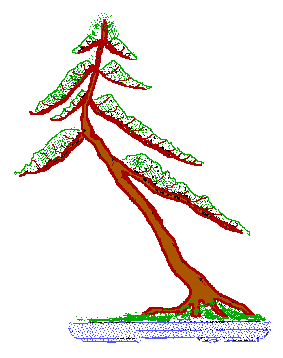
A bonsai is a tree in a container. Bonsai are trained to present a natural appearance at a small size, often in a Japanese style. The term "bonsai" is both singular and plural.

A bonsai is not a houseplant.
While there are some tropical trees that can survive indoors,
bonsai are normally kept outdoors and brought inside only for short
periods on special occasions. Keeping a bonsai indoors will usually
kill it. Keep your bonsai outdoors and water daily in hot weather.
I trained this juniper in the cascade style with guidance from Penny Jensen.
Many different tree species are used for bonsai, especially deciduous
and conifer trees. Conifers include pine, juniper, cedar, cypress, and redwood.
Deciduous trees include maple, elm, ginkgo, and oak.
Bonsai are kept outdoors on shelves.
Bonsai trees can come from temperate or tropical regions. A tropical tree
popular for bonsai is the banyan.
Fruit trees make good bonsai. These include cherry, plum, quince,
olive, and pomegranate.
This is a deciduous bonsai, a cork oak forest with 11 trees.
Climate is especially important in caring for bonsai. A tree must be alive
to be a bonsai. That's the first rule of bonsai: don't kill it. Failing to
water your tree will cause its death. Rain is the best source of water for
bonsai, but people live in places where it may not rain frequently, so they
must water several
times a week, even daily in hot and dry climates. Growing bonsai will give
one an added appreciation for the seasons and the
weather
.
This is a California Juniper collected in 1992 from the high desert and styled by
Harry Hirao.
This is another shot of the same tree with me posing beside it
(photo taken December 28, 1995).
Knowledge of Bonsai is really about looking at trees. The most important feature of a tree
is its root structure. A tree should not just disappear into the ground like
a telephone pole. It should flair out and show the roots radiating from the
trunk. This gives an appearance of age and stability. The next thing one should
see in a tree is the trunk. The trunk should be thick at the base and taper
continuously to its apex.
A seven-tree Japanese black pine forest by Jim Tatsukawa.
Every bonsai has a front. The tree should be viewed from the front
with the eye-level at a point about two-thirds of the height of the
tree.
This is a juniper informal upright style. Guidance by Leila Kusume.
A bonsai should have a prime number of trunks.
This is a a triple trunk juniper given to me as a graduation present by Bill Johnson.
Exposed dead wood on a tree is called "jin." Jin gives a tree a rugged, weathered
appearance.
This juniper has a great amount of jin on the right side. Guidance by Jim Tatsukawa.
Trees exposed to strong wind develop a windswept style.
This is windswept juniper. Guidance by Leila Kusume.
I have prepared a bonsai demonstration to show how a partially trained tree is pruned, wired, and potted in a bonsai pot.
Image by
Jim Gray.
 Richard dot J dot Wagner at gmail dot com
Richard dot J dot Wagner at gmail dot com
 USC home
page.
USC home
page.
This page copyright © 1995-2010 by Rick Wagner, all rights reserved.
Updated April 8, 2002.